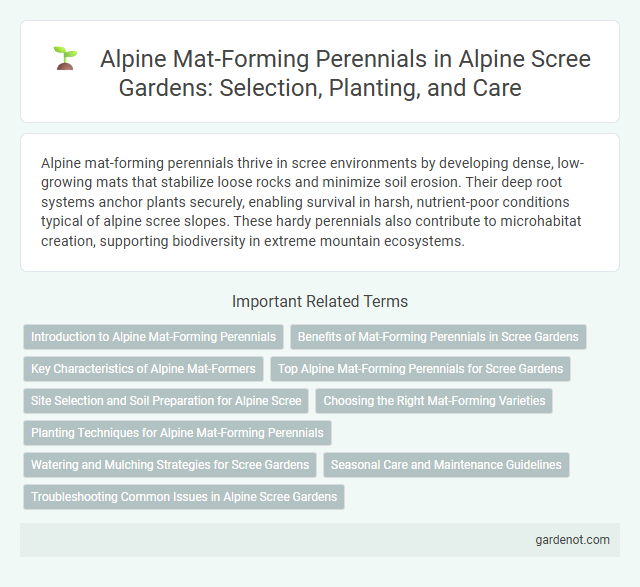Alpine mat-forming perennials thrive in scree environments by developing dense, low-growing mats that stabilize loose rocks and minimize soil erosion. Their deep root systems anchor plants securely, enabling survival in harsh, nutrient-poor conditions typical of alpine scree slopes. These hardy perennials also contribute to microhabitat creation, supporting biodiversity in extreme mountain ecosystems.
Introduction to Alpine Mat-Forming Perennials
Alpine mat-forming perennials are specialized plants adapted to thrive in harsh mountainous environments characterized by rocky scree slopes with poor soil and extreme weather conditions. These plants exhibit low-growing, dense mats that reduce water loss and protect roots from temperature fluctuations, contributing to soil stabilization and ecosystem resilience. Key species, such as Saxifraga and Silene, play vital roles in alpine biodiversity by providing habitat and food sources for insects and small mammals.
Benefits of Mat-Forming Perennials in Scree Gardens
Mat-forming perennials in Alpine scree gardens enhance soil stability by creating dense root networks that prevent erosion on steep, rocky slopes. Their low growth habit reduces water loss through evaporation, improving moisture retention in arid, well-drained scree environments. These perennials also provide critical habitats for alpine pollinators, supporting biodiversity in harsh mountainous ecosystems.
Key Characteristics of Alpine Mat-Formers
Alpine mat-forming perennials exhibit dense, low-growing foliage that effectively conserves moisture and withstands harsh mountain winds. Their extensive root systems stabilize scree slopes, enhancing soil retention and preventing erosion in alpine environments. Specialized adaptations such as hairy leaves and compact growth form minimize water loss and protect against intense UV radiation at high altitudes.
Top Alpine Mat-Forming Perennials for Scree Gardens
Alpine mat-forming perennials such as Saxifraga oppositifolia, Sedum album, and Phlox subulata thrive in scree gardens, providing excellent ground cover and soil stabilization. These plants exhibit exceptional drought tolerance, compact growth, and vibrant blooms that enhance rocky landscapes. Their ability to withstand harsh alpine conditions makes them ideal choices for creating resilient, visually appealing scree environments.
Site Selection and Soil Preparation for Alpine Scree
Alpine mat-forming perennials thrive in well-drained, rocky substrates commonly found in alpine scree environments where soil is coarse, sandy, and low in nutrients. Selecting a site with optimal sunlight exposure and minimal competition from larger vegetation ensures robust growth and mat formation. Soil preparation should emphasize improving drainage and incorporating coarse materials like gravel and sand to mimic natural scree conditions critical for the establishment of these resilient perennials.
Choosing the Right Mat-Forming Varieties
Selecting the right Alpine mat-forming perennial varieties involves prioritizing species such as Silene acaulis, Androsace alpina, and Saxifraga oppositifolia, which thrive in well-drained scree environments. These mat-forming plants exhibit low-growing, dense foliage that stabilizes soil and withstands harsh Alpine conditions, including extreme temperatures and high UV exposure. Opt for varieties with proven resilience to frost and drought to ensure successful establishment and long-term ground cover in Alpine scree gardens.
Planting Techniques for Alpine Mat-Forming Perennials
Alpine mat-forming perennials thrive in well-drained, rocky soils that mimic their natural scree habitats, making careful soil preparation essential for successful planting. Incorporating grit or coarse sand improves drainage and prevents root rot, while planting crowns just above the soil surface encourages healthy growth and mat formation. Regular mulching with fine gravel maintains soil moisture and temperature, supporting robust establishment and long-term resilience in alpine conditions.
Watering and Mulching Strategies for Scree Gardens
Alpine mat-forming perennials in scree gardens require minimal watering, primarily during prolonged dry periods to mimic natural moisture conditions. Applying a thin layer of coarse gravel mulch helps retain soil moisture, reduces erosion, and enhances root insulation against temperature fluctuations. Proper mulching combined with targeted watering supports plant health and encourages dense mat formation characteristic of healthy Alpine scree ecosystems.
Seasonal Care and Maintenance Guidelines
Alpine mat-forming perennials thrive best with well-drained, rocky soil that mimics their natural scree environment, requiring minimal watering during dry seasons to prevent root rot. Pruning dead foliage in early spring promotes healthy growth and maintains compact mats, while mulching with coarse gravel aids moisture retention and discourages weed competition. Seasonal care also involves monitoring for pests like aphids and removing debris to reduce fungal infections, ensuring the plant's resilience in harsh alpine conditions.
Troubleshooting Common Issues in Alpine Scree Gardens
Alpine mat-forming perennials like Saxifraga and Androsace often face issues such as root rot caused by poor drainage in Alpine scree gardens. Ensuring gravelly, well-drained soil with proper air circulation mitigates fungal infections and encourages healthy growth. Monitoring moisture levels and correcting soil pH around 6.0 to 7.0 improves nutrient uptake and reduces stress on these hardy plants.
Alpine mat-forming perennial Infographic

 gardenot.com
gardenot.com